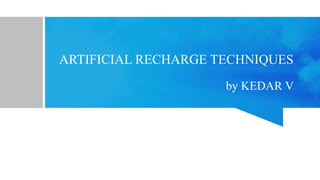
Artificial recharge techniques by kedar v
- 1. ARTIFICIAL RECHARGE TECHNIQUES by KEDAR V
- 2. WHY DO WE NEED WATR RECHARGE? • Due to present water demand. • Because of low water availability. • To withstand for the future water problems. • By 2050 , the water availability will be less than needed. • It is well known that out of 100 people nearly 10-15 are in lack of water. • To withstand the water crisis.
- 3. WATER WITHDRAWLS Public usage 66% Industrial usage 18% Commercial usage 3% Domestic Purpose 5% Irrrigation & Agriculture 8% Public usage Industrial usage Commercial usage Domestic Purpose Irrrigation & Agriculture
- 4. WHAT IS ARTIFICIAL RECHARGE? • Aritificial Recharge is the process of by which the ground water recharge is increased at the rate much higher than the natural condition of percolation.
- 5. WHY ARTIFICIAL RECHARGE? • In low rainfall areas of the country the availability of utilizable surface water is so low that people have to depend largely on ground water for agriculture and domestic use. • So in order to imrpove the groung water , it is necessary to artificially recharge the depleted ground water aquifers.
- 6. IDENTIFICATION OF AREAS FOR RECHARGE • Where availability of water from wells and hand pumps is inadequate during the lean months. • Regeneration of water in pumps and wells is slow after some water has been drawn. • Where water levels are declining due to over- exploitation.
- 7. QUALITY OF SOURCE WATER • Problems which arise as a result of recharge to round water are mainly related to quality of raw waters that are available for recharge and which generally require some of treatment before being used in recharge installations.
- 8. METHODS OF ARTIFICIAL RECHARGE ARTIFICIAL RECHARGE SURFACE SUB-SURFACE
- 9. SURFACE TECHNIQUE • Flooding • Basins & PercolationTanks • Stream Augmenation • Ditch & Furrow System
- 10. SURFACE METHOD • It is also called as spreading method. • It is suitable where for large area of basin is available and aquifers are unconfined without impervious layers. • Here , the rate of filtration depends on the nature of top soil , if soil is sandy the infiltration is higher and viceversa. • Water quality also affects the rate of percolation. • The presence of solid particles in the water can clog the soil.
- 11. FLOODING • This method is suitable for relatively flat topography. • The water is spread as a thin sheet. • It requires a system of distribution channel for the supply of water for flooding. • Higher area of vertical infiltration is obtained on areas with undisturbed vegetation and sandy soil covering.
- 12. BASINS & PERCOLATION TANKS • This is the most common method of artificial recharge. • In this method , water is impounded in series of basins or percolation tanks. • The size of basin may depend upon topography of area. • This method can be applicable for almost all type of soils.
- 13. STREAM AUGMENTAION • Seepage from natural sources or rivers is one of the most important source of recharge of the ground water recharge. • The runoff can be arrested through the check bunds or widening the steam bed thus larger area is available to increase the infiltraion. • To utilize the runoff more check dams may be constructed.
- 14. DITCH & FURROW SYSTEM • In areas with irregular topography ditches and furrows provide maximum water. • This technique consists of a system of shallow flat bottomed and closely spaced ditches , which are used to carry water from source like streams and canals to provide more percolation.
- 15. SUB-SURFACE METHOD • In this method the structure lies below the surface and recharges the water directly. • The important structure commonly use are recharge wells , recharge shafts , dug wells , etc,.
- 16. RECHARGE WELL • They are of two types 1)Injection well 2)Recharge well
- 17. INJECTION WELL • They are similar to tube wells • Deeper the aquifers the more the augmentation occurs. • The method is suitable to recharge single or multiple aquifers. • This method is more costly and required specialized techniques.
- 18. RECHARGE WELL • This wells are two types DRY and WET. • In wet type of recharge well the screen is kept below the water table and have been found very succesful. • In dry type it is purely opposite and may causes clogging.
- 19. PITCH & SHAFTS • Used in areas where impervious layer is encountered at shallow depths. • These are very expensive to recharge the aquifer directly. • Generally diameter of the shaft will be 2m to accomodate more water. • They do not require larger areas like other techniques.
- 20. DUG WELLS • These dug wells can be used as recharge structure strom water and other surplus water from canal and can be diverted to these dugs to recharge the aquifers directly. • The water is guided through the pipes to the bottom of well to avoid entrapment of bubbles in the aquifer.
- 21. IN-DIRECT RECHARGE TECHNIQUE • INDUCED RECHARGE
- 22. INDUCED RECHAREG • It is an indirect method of artificial recharge involving pumping from aquifer hydraulically connected with streams , lakes , rivers . • This method is effective where stream bed is connected to aquifer by sandy formation.
- 23. WHAT CAN WE CONCLUDE? • Ground availability would remain limited. • Reduction in run-off. • Improvement of ground water quality. • Increase in Irrigation.
- 24. THANK YOU by KEDAR V 11149K019